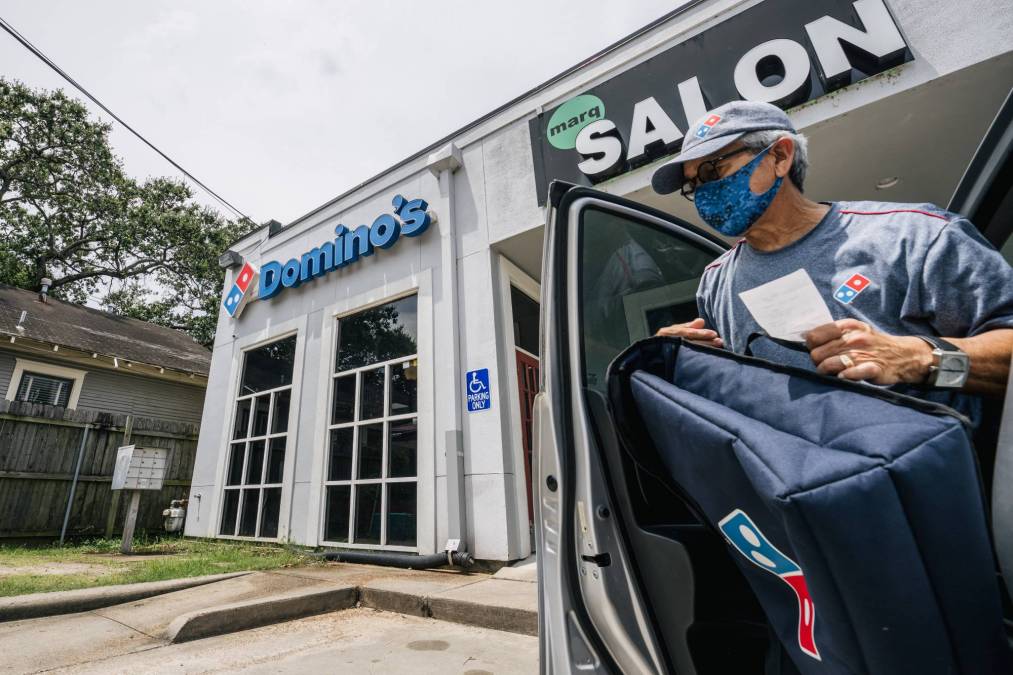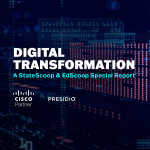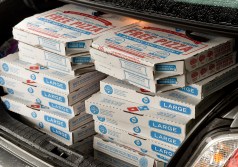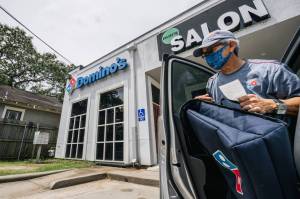Why government technologists love the Domino’s pizza tracker

As a native Chicagoan, Scott Jensen has some opinions on pizza. The former director of the Rhode Island Department of Labor and Training grew up partial to a local purveyor of deep pan and crispy thin-crust pies.
But one night in spring 2020, flummoxed by the COVID-19 pandemic’s overwhelming of the unemployment insurance system he ran — and far from the Midwest — Jensen ordered from a brand more associated with stoned college kids: Domino’s. At the time, about 200,000 Rhode Islanders had lost their jobs due to the early waves of the pandemic, and as in nearly every other state, the unemployment insurance system was breaking under the stress of record-busting demand and limited processing capacity.
Jensen didn’t order Domino’s for the test-lab-perfected pizzas, wings or cheesy bread. He did it to test out the 18,000-location-strong chain’s delivery tracker. He wanted to see if it might offer a hint of how to fix Rhode Island’s faltering unemployment benefits at the peak of the crisis.

Scott Jensen (LinkedIn)
“We were working with the [professional services] people at [Amazon Web Services] and we were in the middle of one of their sessions,” Jensen says, recalling one of many virtual meetings Rhode Island DLT held to address its shortfalls. “We were describing the use case of a person who’s very anxious about what’s going on” — like the status of an unemployment check — “and we were describing what we wanted to do.”
At the pandemic’s onset, Rhode Island’s unemployment insurance system, based on a 30-year-old IBM A/S 400 midrange computer, was equipped to process up to 8,000 claims per day, while a website for people checking the status of their payments could handle about 300 requests at a time before it crashed — which it did. And with the website down, people started flooding the state’s call center, creating even more backlogs.
Jensen and his team told the AWS reps they wanted to build system where people could get automated updates about the status of their unemployment claims, reminders if they needed to provide documentation and confirmations when a payment goes out. That’s when the agency’s 25-year-old communications director, Angelika Pellegrino, chimed in.
“You know what, that’s just like the Domino’s pizza tracker,” Jensen recalls Pellegrino saying.
That evening, Jensen downloaded the Domino’s app and put in an order. The app showed his pizza’s step-by-step journey — from the kitchen prep table, to the oven, to its placement in the delivery driver’s car and its final journey to his doorstep. Jensen might not have enjoyed his dinner, but he was impressed by the user experience.
“It’s genius,” he says. “It really catches on because in order to build that tracker, what it requires is native cloud technology thinking about the customer. It’s just putting sensors in Domino’s so you know they’re making the pizza, it’s in the oven, it’s going out to the car. And having a GPS unit in every car so you know where it is.”
Origins
The Domino’s tracker dates to 2008, when it was added to the company’s website. While it was credited with boosting sales, it did little to improve the company’s culinary reputation or inaccurate delivery estimates. It took off in 2011, when Domino’s joined the mobile app boom under then-CEO Patrick Doyle, who had taken over in 2010 with ambitions of converting the chain into a “tech-to-table” operation — eventually moving its entire tech team in-house — and making the chain’s food more palatable and delivering it on time.
The Domino’s tracker gives its customers updates on the status and location of their orders. (Domino’s)
Over the years, Domino’s has added options for ordering by smartwatch, digital assistants like Amazon Alexa and social media: Loyal customers can order by simply tweeting a pizza emoji at the company, which claims online orders account for more than 60% of total sales.
“We view ourselves as a work-in-progress brand,” Doyle told CNBC in 2017. “We continue to find places that we can improve the experience for the customer and as long as we are making investments that do that, that can permanently improve the experience for our customers and we think we are going to continue to grow.”
To government techies responsible for delivering services more vital than pizza, Doyle’s approach is worth emulating.
A ‘fatal’ effect
“I like other kinds of pizza,” says Jensen. “But that app is great. I think what the public sector is seeing is that the private sector has opted for human-centered design before the public sector did.”
After the pizza-tracker epiphany, Jensen’s agency started moving components of its unemployment system into a cloud environment, where it could be scaled up, beginning with a virtual replica of the A/S 400. It processed claims quicker and eased demand on the call center.
“There was a limit on our terrestrial computing power, and I was not sleeping at night because I knew if that many people are going to try to hit it, they’re all going to call and it’s going to that backed up,” Jensen says. “And when they get a busy signal, they call the local TV stations and the Providence Journal and all their elected officials — which they should. But then all those same people are going to call the same numbers we didn’t have enough people picking up the first time. The snowball effect is fatal.”
In Domino’s, though, Jensen sees an “application of cloud technology that’s perfect.”
‘It’s all about workflow’
Jensen is not the only state government official to eye Domino’s with admiration. In July, Missouri Chief Information Officer Jeffrey Wann told members of his state legislature that “there’s no reason why our citizens can’t have the same experience that I had yesterday ordering pizza from Domino’s.”
With Missouri due to receive about $2.8 billion from the American Rescue Plan, Wann is eyeing a six-year digital transformation of Missouri’s government services, and the pizza tracker has been a valuable reference point as he makes his case to his superiors.
“The pizza is very easy for people to understand so I can easily walk them through why and show what we are planning to do,” says Wann. “What we need to do with state government is so much more difficult.”

Jeffrey Wann (LinkedIn)
But Domino’s, Wann says, provides state government a template.
“They know who you are,” he says. “For a state, that translates into single sign-on. Most states — and we’re right along with them — have different sign-ons and IDs for the different components of government. The citizen experience starts out not being good. Domino’s does it very well.”
Wann says work on a single sign-on platform for Missouri’s statewide agencies could begin as soon as next year. Residents who file for unemployment insurance, for example, won’t need to re-enter all their information if they later apply for a different benefit.
“Right now, Department A doesn’t talk to Department B, so you have to put in the same information over and over again,” he says.
Wann says he likes fact that Domino’s remembers its customers’ order histories. (His usual is a thin-crust pie with ground beef and banana peppers.)
“It’s all about workflow and orchestration and communication and knowing the customer and reducing the friction points,” he says.
‘IT can’t solve it all’
Back in Rhode Island, Jensen’s former colleagues are preparing to launch their version of the pizza tracker. The state’s Department of Labor and Training Department expects to launch its new unemployment insurance website, called “UI Online Plus,” by the end of the year. One of its standing features will be a graphic showing the status of an applicant’s claim that stays on top of the page. There’s also a chatbot named “Hope” and options for automated phone, text or email updates.
“The Domino’s pizza tracker is basically two parts: When it’s in the store and when your pizza’s on the way with GPS,” says Jensen, who’s now the CEO of Research Improving People’s Lives, a nonprofit that promotes the use of data science and technology in social policy. “The UI journey is a little bit more complicated than that, but what they’re trying to do is you have to look at that claims process, the journey of a claim, and you’ll be able to see it.”
But no digital service is perfect. Domino’s still gets its share of complaints about late deliveries, missing items and delivery drivers who do not match the names given on the app, the Wall Street Journal reported in 2017.
And since his July statehouse testimony, the Missouri CIO says he had an order arrive late and that the apology coupon his local Domino’s gave him expired before Wann realized it was only good for one week.
“All of a sudden my great positive experience turned into a negative one,” he says. “Not only was the pizza late, the coupon was useless.”
But that, Wann says, was a reminder that digital transformations are ultimately reliant on human performance and organizations’ processes.
“IT can’t solve it all,” he says. “You’ve got to make sure you think things through, you gotta make sure all the parameters are in your control.”

This story was featured in StateScoop Special Report: Digital Transformation (2021)






